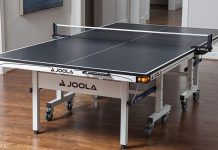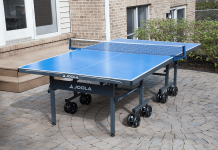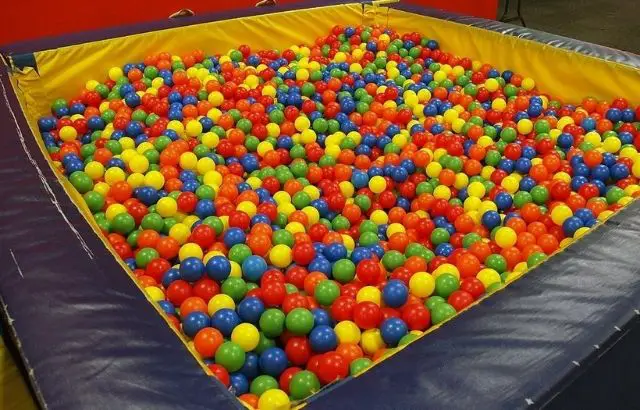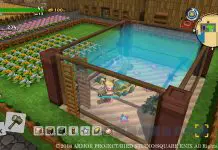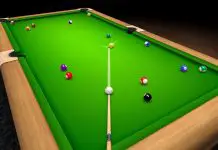You may be wondering if you need a complete tutorial on how to make a ball pit?! And the answer is ‘yes, you do’. It would help if you had a pool, balls, and the right proportions and sizes, and he should be able to withstand the action simultaneously from a group of toddlers. So if you want guaranteed success, you have come to the right place.
Table of Contents
How to Make a Ball Pit: Materials Required
- Play pen balls (approx. $0.20/ball)
- Wood (varies depending on size)
- Foam padding ($20/pack)
- Screening ($10/roll)
- Glue ($3-5)
- Hammer ($10)
- Nails ($5)
- Staple Gun ($20)
- Staples ($3)
- L-brackets ($10)
- Tarp (if outdoors, $10)
- Child’s basketball net ($5)
- Inflatable shark ($2)
How to Make a Ball Pit
Decide on your size and location.
Unless you have a very large budget, you probably won’t be able to fill your living room with playpen balls, as this will be very expensive. A small spare room or balcony/patio area can be great as you can divide the area for activities with ball pit balls, allowing you to keep the size to a minimum (and therefore cost).
If you choose to use your balcony, make sure it has a roof, or you can otherwise seal the area so that no one can escape from the ball and water or outside hazards (such as bugs) can get inside. Also, remember the position of your ball pit is important for safety and economic reasons. Making your ball pit into a corner, for example, can eliminate the need for you to make two sides of your frame.
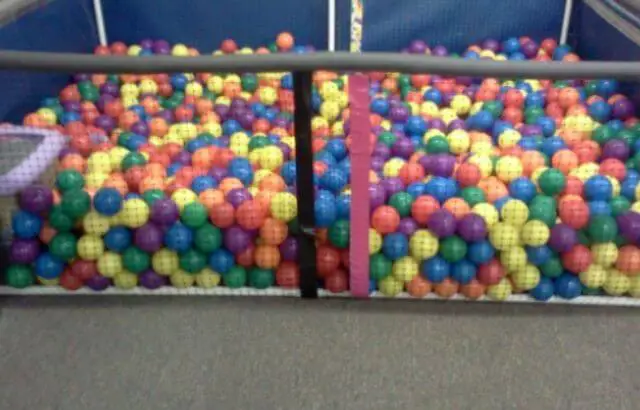
Get some balls
Use the calculator; you will now know how many playpen balls you have to buy. The numbers seem big at first, as the chances are that you – like most people – will only need a few hundred balls to fill your pool with balls. Trust the math here, though: a 4×8′x2.5 ′ ball pit will need more than 5,000 balls.
Search online for cheap playpen balls. Amazon is a good place to find cheap balls. If they are used, don’t forget to clean them. Wash it in your bathtub and/or spray it before soaking it somewhere with one part bleach, a nine parts water solution. Do not place the wet ball in your ball pit.
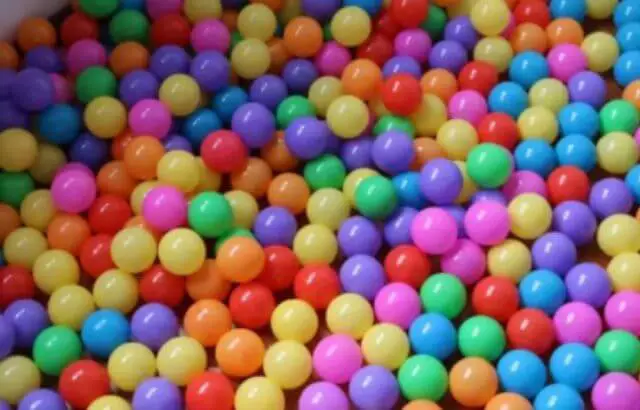
Close your ball pit area
The last thing you want is for your balls to roll all over the place. Make sure you can somehow get them to either avoid the ball pit or the area where the ball pit is located. If you are building a standard ball pit on your balcony or in a room with short windows, you will want to place the screen in any area where the balls can escape.
Luckily, the screen is relatively inexpensive at around $10/roll. The staple gun makes the screen extremely easy to try fast, especially if you’re outdoors. If you are building on a balcony, you can screen the entire area from top to bottom or simply create a screen around the pit, leaving a hole or slit to let you in or out. Your screen can get a lot of stress when people play your ball in the pit, so be sure to use strong material.

Assemble your frame
Chances are pretty good that you’re going to have drunk or otherwise some effortlessly excitable friends playing in your ball pit. And really, what does it mean to be otherwise? As such, you want to make sure you have built yourself a strong frame. In this field, you and your friends are the most important to get in and out of the pit.
For example, 8 ′ long 2 ″ x4 ″ planks are used up and down and 3 ″ 4 tall 4 ″ 4 ″ posts for the sides. Since people are hoping to get into the ball pit, this needs to be made more rigid. First, hammer the frame together, and then strengthen it by adding L-brackets. Nail large plywood boards on all four walls inside and open walls on the outside.
You can use more L-brackets on the inside corners of the ball-pit to connect the sides and secure the walls to your floor (a foam cushion will cover this).
Friend-proof your ball pit
Now you have a huge, heavy wooden box. For you and your agitated friends to play is exactly the most fun – or not the safest. From here comes the foam padding. You can buy 4 2′x2 ′ interlocking foam pads at Wal-Mart for about ′ $20 a pack.
This ball is the perfect material for both the pit floor and walls as it is soft, durable, and easy to clean. You will need 128 square feet of foam padding or about 8 packs to cover the inside of the 4′x’3′x8 ′ box.
Start with the first ball pit floor; hastily lick all the pieces together. Once the floor is covered, start moving to the sides; first, go around the bottom, attaching the pieces to the floor pieces. Glue the foam padding to the side of the frame once you have reached all the places.
Use large-headed nails (so they can’t just slip through the stretched foam) to make sure the pieces stay in place. Once you have completed the bottom surface, you can move around to the next level, gluing/nailing the pieces wherever you go with it. By this time, you will notice that the padding ball stands higher than the pit wall’s higher height.
If you used a 2 2 squared pad, you should have it 4 ′. So, your ball pit fit is only 3 inches high, which allows you to get rid of any extra lumps on the top of your walls. It cover any sharp edges, nails, potential thorns, or anything else that could hurt you or your friends when jumping around in your almost concluded ball pit.
Put in the balls
Without a doubt, this is the best step of this training. Just start pouring them. If you can find a friend pouring the balls while you fix the bottom, it will be a fun, lifelong experience.
Add Toys, friends, and have fun!
A small basketball net is necessary for any ball pit fit. Not only is it fun to blow hoops from playpen balls, but because it will give people something to throw apart or you. Also, an inflatable shark only makes sense. Every ball pit should have sharks in it. Now log into your awesome colorful box, call all your friends, prove to them that you have really completed this and aren’t just pulling their leg, and enjoy a blast!
How to Make a Ball Pit: FAQs
How much will it cost to make a ball pit?
The average range of buying a bundle of 100 balls is somewhere around $ 20. Check out the latest prices. You can also buy a bundle with more pit balls if you wish, but the cost to make a ball pit is usually no more than $ 100 to $200.
What do you fill with a ball pit?
You can fill the ball pit with the following materials:
- Stuffies
- Foam, sand, or water for sensory play and exploration
- Foam blocks
- Balls
- Pillows.
- A crash pad
How many balls do you need for a small ball pit?
Each case of 500 balls fills about 6.1 cubic feet. Now for the number of balls that the mini ball pits can fit into the pit. To determine how many cubic feet you want to fill with the ball, measure your ball’s length, width, and depth inside the pit.
Conclusion
See? It’s not hard to make your DIY ball pit pool, but a little knowledge goes a long way! This game will give you hours so far, and I can see more in the future. There’s something about the ping pong balls that just screams pure excitement. You can’t sit in a ball pit and not laugh. It feels like you’re turning to gels and floating on plastic bubbles of multi-colored fun.
One who has spent most of their summers in the balcony ball pit, talking about its stress-relieving effects or “determining what it means to be an’ adult in the 21st century or even what you’ve dreamed of. As a kid/teen/college student, but really, it’s an activity with ball pit balls on the balcony. How wonderful does that sound?

Carl works as a charted account by day, and sports enthusiast and amateur fiction writer by the weekend. He was a multi-sport athlete in his school days and played Division 3 lacrosse in college. He is a gear freak and is always looking for an excuse to upgrade his sports equipment. When not working or playing, he likes to hike and explore the countryside. Carl is a certified basketball athlete by the Basketball Association of America and has participated National Basketball League in 2016. He played for Akron Goodyear Wingfoot’s.
Moreover, Carl is also a badminton expert and he is playing it since 2006 when he was at standard 8. He has won several badminton championships and one remarkable is the Yonex USA International 2015. Also, he is an expert in Bowling.
Carl is the Co-Founder & Editor-In-Chief of Indoor Games Zone. He shares his expertise on basketball, badminton, and bowling on our website to help people get the best tips and products they are searching for.
- Basketball
- Badminton
- Bowling

![Stiga XTR Pro Review | 1,559+ Global Ratings (In-Depth Guide) [year] Stiga XTR Pro Review](https://indoorgameszone.com/wp-content/uploads/2021/08/Stiga-XTR-Pro-Review-218x150.jpg)

